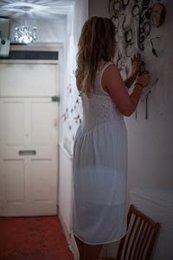Inside a terraced house painted pink and clothed on the outside with tea cups, which hang from hooks driven into the wall, wander a group of women. Maybe there are ten of them, maybe there are more. After a while, it becomes difficult to count. They move from room to room, or between upstairs and downstairs, pass by you on a corridor. After a while, it doesn’t matter how many there are, because this site-specific piece of work is metaphorical rather than literal, and while each of the women has a definite narrative to tell, it is often more implicit than explicit, and the audience is as likely to walk away from the work with a feeling, or an emotion, as they are a clearly formed picture of what the production is trying to say.
This is Hungry Tea, the product of a collaboration between the Cork-based community art group, Creative Connections, and British artist and theatre director Mark Storor, who is known for his work with marginalised groups – in the past he has worked with gay prisoners, and also created a piece of work from the stories of liver transplant patients.  Storor worked with the women to root out their stories and their most natural performance style – he is not a prescriptive director, at one point telling the Guardian newspaper that instead of rehearsing theatre in a traditional manner, he seeks out images, rituals and the personal experiences of the groups with which he works and throws them all together into a kind of giant mixing bowl. “It’s like a stew,” he said at the time, “Good dumplings rise to the top.”
Storor worked with the women to root out their stories and their most natural performance style – he is not a prescriptive director, at one point telling the Guardian newspaper that instead of rehearsing theatre in a traditional manner, he seeks out images, rituals and the personal experiences of the groups with which he works and throws them all together into a kind of giant mixing bowl. “It’s like a stew,” he said at the time, “Good dumplings rise to the top.”
The dumplings, in this instance, begin at the front entrance hall. Onto a wall covered in spoons, pieces of bread and daubs of jam, a woman dressed in white is gluing small type-written notes. Reading the notes, it becomes clear they reflect the experiences of a person in pain, possibly with anorexia. Paranoia, fear, doubt, self-hatred, float about the wall. Is the woman telling us her own story? She stands at the wall, unmoved, fixing, gluing, adjusting.
Inside the kitchen and living room are some more women. One makes bread, pointing out to visitors the butter and the jam. Another sits inside the kitchen sink, painting her legs; beside her, on the floor, a woman makes dresses out of blue dishcloths. In the garden, a woman is painting the concrete steps. As the audience passes, some of the women look up, and smile. Others concentrate, head down, on their tasks. It becomes a strange, unsettling experience, akin to wandering into a stranger’s house, invading the space of another.
 In a room off the living room stands another woman, a native of the Congo dressed in bright African garb. Hand-drawn charcoal maps of the African continent cover the floor and walls, and some earth is also strewn across the floor. This woman’s story is less elusive; she is ready to tell it, if the audience is prepared to engage with her, and many people do.
In a room off the living room stands another woman, a native of the Congo dressed in bright African garb. Hand-drawn charcoal maps of the African continent cover the floor and walls, and some earth is also strewn across the floor. This woman’s story is less elusive; she is ready to tell it, if the audience is prepared to engage with her, and many people do.
For this writer, at least, it is the rooms upstairs that prove most interesting. In one, a woman dressed in black circles the walls with charcoal, creating figurative images that resemble Munch’s famous painting 'The Scream'; in a room alongside, a woman clothed only in a bedsheet and smoking what looks to be a rolled-up piece of paper, stands in a room literally turned upside down – the furniture hanging from the ceiling – on a floor spread with tea-leaves. On occasions, the woman turns and disappears into an alcove behind a white gauze veil, as if she is literally merging with the room.
It is a fascinating, contemplative work, at turns uncomfortable, at others strangely calming. Storor has clearly encouraged the women to express themselves in the manner that feels most natural, and although the layers of text and subtext in each part of the house are never necessarily stripped away and revealed, it is clear that these women have worked deeply to arrive at where they are now.
At the point of leaving, each member of the audience is asked to write a note, or a comment, that will be pinned along with the teacups on the outside of the house. Many of the notes are filled with simple pleasure. “Enthralling and captivating,” reads one. “This is the best thing I have ever seen,” says another. But one appears to capture the spirit of this captivating show: “How lovely to go to something that asks more questions than it answers,” it says. Those questions will linger, long after one has closed the door and said goodbye.
Rachel Andrews is an arts journalist and critic based in Cork.